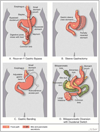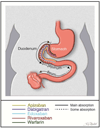Oral Anticoagulant Use After Bariatric Surgery: A Literature Review and Clinical Guidance
- PMID: 28159600
- PMCID: PMC5401640
- DOI: 10.1016/j.amjmed.2016.12.033
Oral Anticoagulant Use After Bariatric Surgery: A Literature Review and Clinical Guidance
Abstract
Bariatric surgery may alter the absorption, distribution, metabolism, or elimination (disposition) of orally administered drugs via changes to the gastrointestinal tract anatomy, body weight, and adipose tissue composition. As some patients who have undergone bariatric surgery will need therapeutic anticoagulation for various indications, appropriate knowledge is needed regarding anticoagulant drug disposition and resulting efficacy and safety in this population. We review general considerations about oral drug disposition in patients after bariatric surgery, as well as existing literature on oral anticoagulation after bariatric surgery. Overall, available evidence on therapeutic anticoagulation is very limited, and individual drug studies are necessary to learn how to safely and effectively use the direct oral anticoagulants. Given the sparsity of currently available data, it appears most prudent to use warfarin with international normalized ratio monitoring, and not direct oral anticoagulants, when full-dose anticoagulation is needed after bariatric surgery.
Keywords: Absorption; Anticoagulation; Apixaban; Bariatric surgery; Biliopancreatic diversion; Bleeding; Dabigatran; Edoxaban; Efficacy; Gastrectomy; Gastric banding; Obesity; Pharmacokinetics; Rivaroxaban; Roux-en-Y; Safety; Thrombosis; Warfarin.
Copyright © 2017 Elsevier Inc. All rights reserved.
Conflict of interest statement
Figures
Comment in
-
Anticoagulant drug choice in patients who have had bariatric surgery - Presently, DOACs are not the preferred choice.Thromb Res. 2018 Mar;163:196-199. doi: 10.1016/j.thromres.2018.01.027. Epub 2018 Jan 31. Thromb Res. 2018. PMID: 29395241 No abstract available.
References
-
- Smith A, Henriksen B, Cohen A. Pharmacokinetic considerations in Roux-en-Y gastric bypass patients. Am J Health Syst Pharm. 2011;68:2241–2247. - PubMed
-
- Edwards A, Ensom MH. Pharmacokinetic effects of bariatric surgery. Ann Pharmacother. 2012;46:130–136. - PubMed
-
- Ponce J, Nguyen NT, Hutter M, Sudan R, Morton JM. American Society for Metabolic and Bariatric Surgery estimation of bariatric surgery procedures in the United States, 2011–2014. Surgery for obesity and related diseases : official journal of the American Society for Bariatric Surgery. 2015;11:1199–1200. - PubMed
-
- Schneider BE, Mun EC. Surgical management of morbid obesity. Diabetes care. 2005;28:475–480. - PubMed
Publication types
MeSH terms
Substances
Grants and funding
LinkOut - more resources
Full Text Sources
Other Literature Sources
Medical
Research Materials



